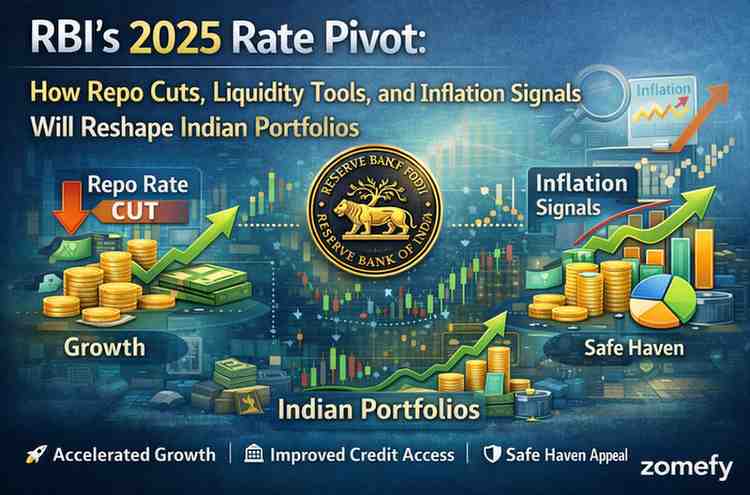Navigating the Impact of RBI’s New Liquidity Framework and Repo Rate Adjustments on Indian Markets in 2025
The Reserve Bank of India (RBI) has ushered in a new era for Indian financial markets with its revised Liquidity Management Framework (LMF) and a recent adjustment to the policy repo rate in 2025.
Navigating the Impact of RBI’s New Liquidity Framework and Repo Rate Adjustments on Indian Markets in 2025
What You Can Do Next
- Read the full article for complete insights
- Save for later reference
- Share with others learning about this topic
Image not available
The Reserve Bank of India (RBI) has ushered in a new era for Indian financial markets with its revised Liquidity Management Framework (LMF) and a recent adjustment to the policy repo rate in 2025. These changes are not just regulatory tweaks—they are strategic moves designed to enhance market stability, improve monetary transmission, and foster economic growth. For retail investors and financial professionals alike, understanding the nuances of these reforms is crucial for navigating the evolving landscape of Indian equities, debt, and banking. The new framework simplifies liquidity operations, aligns market rates more closely with the policy repo rate, and introduces greater transparency in the central bank’s liquidity management. At the same time, the reduction in the repo rate to 6.00% and the shift to an accommodative stance signal a supportive environment for growth, but also bring new risks and opportunities. This article provides a comprehensive analysis of the RBI’s latest liquidity and rate changes, their implications for various market segments, and actionable strategies for investors and institutions to adapt and thrive in this new regime.
Understanding the RBI’s Revised Liquidity Management Framework
The RBI’s new Liquidity Management Framework (LMF), finalized in September 2025, marks a significant shift in how liquidity is managed in the Indian banking system. The core objective is to simplify operations, reduce uncertainty, and ensure that market rates remain closely aligned with the policy repo rate. The framework retains the overnight Weighted Average Call Rate (WACR) as the operating target for monetary policy, with the repo rate at the center of a symmetric corridor flanked by the Standing Deposit Facility (SDF) and Marginal Standing Facility (MSF) at ±25 basis points. This means that the SDF acts as the floor (lower bound) and the MSF as the ceiling (upper bound) for short-term interest rates.
A key operational change is the discontinuation of the 14-day Variable Rate Repo (VRR) and Variable Rate Reverse Repo (VRRR) as the main tools for managing short-term liquidity. Instead, liquidity will be managed primarily through 7-day VRR/VRRR operations, with other short-tenor operations (from overnight to 14 days) used as needed. The RBI will provide at least one day’s advance notice for liquidity operations, except in urgent situations, to enhance transparency and reduce market uncertainty.
The requirement for banks to maintain at least 90% of their prescribed Cash Reserve Ratio (CRR) on a daily basis remains unchanged. Standalone Primary Dealers (SPDs) now have access to SDF and repo operations of all tenors, which broadens their participation in liquidity management.
The table below summarizes the key changes in the new LMF compared to the previous framework:
Key Changes in the Liquidity Management Framework
The transition from the old to the new LMF brings several notable changes that impact both banks and market participants. The most significant change is the shift from 14-day to 7-day VRR/VRRR operations as the primary tool for managing short-term liquidity. This change is designed to make liquidity management more responsive to market conditions and reduce the risk of sudden liquidity shocks. The retention of durable liquidity instruments such as Open Market Operations (OMOs), long-term VRR/VRRR, and forex swaps ensures that the RBI has a comprehensive toolkit to manage both short-term and long-term liquidity needs.
The requirement for banks to maintain 90% of their prescribed CRR daily remains in force, which helps to ensure that banks have sufficient liquidity buffers. The expanded access for Standalone Primary Dealers (SPDs) to SDF and repo operations of all tenors is expected to increase market depth and improve price discovery in the money market.
The table below provides a detailed comparison of the old and new LMFs:
Repo Rate Adjustments and Their Market Impact
In April 2025, the RBI’s Monetary Policy Committee (MPC) unanimously decided to lower the policy repo rate by 25 basis points to 6.00%, changing the stance to 'accommodative'. This dovish shift is a clear signal that the RBI is prioritizing growth and supporting economic activity. The SDF rate now stands at 5.75% and the MSF rate at 6.25%, maintaining the symmetric corridor around the repo rate.
The accommodative stance implies that future MPC outcomes are likely to be either a status-quo or a further cut, providing policy rate guidance without direct guidance on liquidity management. The RBI Governor emphasized that the MPC will 'proactively' take liquidity measures to keep liquidity adequate, with a surplus of around 1% of Net Demand and Time Liabilities (NDTL) considered reasonable.
The reduction in the repo rate is expected to lower borrowing costs for banks and corporates, stimulate investment, and support consumer spending. However, it also brings risks, such as potential inflationary pressures and reduced returns on fixed-income investments. The table below shows the impact of the repo rate cut on key interest rates and market segments:
Impact on Interest Rates and Market Segments
The repo rate cut has a direct impact on various interest rates and market segments. For banks, the cost of borrowing from the RBI is now lower, which can be passed on to borrowers in the form of lower lending rates. For corporates, lower borrowing costs can lead to increased investment and expansion. For consumers, lower interest rates can make loans more affordable, boosting demand for housing, autos, and other big-ticket items.
However, the reduction in interest rates also means lower returns on fixed-income investments such as fixed deposits, bonds, and debt mutual funds. This can affect the income of retirees and conservative investors who rely on fixed-income instruments for regular income.
The table below provides a comparison of key interest rates before and after the repo rate cut:
Implications for Equity and Debt Markets
The new liquidity framework and repo rate adjustments have significant implications for both equity and debt markets. For equities, lower interest rates generally support higher valuations as the cost of capital decreases and corporate earnings improve. Sectors such as banking, real estate, and consumer durables are likely to benefit from lower borrowing costs and increased consumer spending. However, the risk of inflation and potential rate hikes in the future could cap gains.
For debt markets, the reduction in interest rates leads to lower yields on fixed-income instruments, which can affect the returns of debt mutual funds and fixed deposits. Investors may need to adjust their portfolios to maintain desired risk-return profiles. The table below compares the performance of key equity and debt indices before and after the repo rate cut:
Equity Market Performance
The equity market has responded positively to the repo rate cut, with major indices such as the Nifty 50 and Sensex showing gains. Sectors that are sensitive to interest rates, such as banking and real estate, have outperformed the broader market. However, the gains have been tempered by concerns about inflation and global economic conditions.
The table below shows the performance of key equity indices before and after the repo rate cut:
Debt Market Performance
The debt market has seen a decline in yields following the repo rate cut, which has led to capital gains for existing bondholders but lower returns for new investors. Debt mutual funds have also seen increased inflows as investors seek to lock in higher yields before further rate cuts.
The table below shows the performance of key debt indices before and after the repo rate cut:
Actionable Strategies for Investors and Financial Professionals
Given the new liquidity framework and repo rate adjustments, investors and financial professionals need to adapt their strategies to navigate the changing market environment. For equity investors, a focus on interest-rate-sensitive sectors such as banking, real estate, and consumer durables is recommended. For debt investors, a shift towards shorter-duration debt instruments can help mitigate the risk of further rate cuts.
The table below provides actionable strategies for different types of investors:
Equity Investment Strategies
Equity investors should consider increasing exposure to sectors that benefit from lower interest rates, such as banking, real estate, and consumer durables. Diversification across sectors and regular portfolio rebalancing are also important to manage risk.
The table below provides a comparison of recommended equity strategies:
Debt Investment Strategies
Debt investors should consider shifting towards shorter-duration debt instruments to mitigate the risk of further rate cuts. Regular monitoring of interest rate trends and portfolio rebalancing are also important.
The table below provides a comparison of recommended debt strategies:
Risk Considerations and Future Outlook
While the new liquidity framework and repo rate adjustments present opportunities, they also bring risks that investors and financial professionals need to consider. The primary risks include potential inflationary pressures, global economic uncertainties, and the possibility of future rate hikes. The RBI’s proactive approach to liquidity management and its commitment to maintaining market stability are positive factors, but vigilance is required.
The table below summarizes the key risks and considerations for investors:
Key Risks and Considerations
Investors should be aware of the following risks and considerations:
- Inflationary pressures: Lower interest rates can lead to higher inflation, which can erode the real returns on investments. - Global economic uncertainties: Global economic conditions can impact Indian markets, especially in times of volatility. - Future rate hikes: The RBI may raise rates in the future if inflationary pressures increase, which can affect the returns on fixed-income investments.
The table below provides a summary of key risks and considerations:
Disclaimer: IMPORTANT DISCLAIMER: This analysis is generated using artificial intelligence and is NOT a recommendation to purchase, sell, or hold any stock. This analysis is for informational and educational purposes only. Past performance does not guarantee future results. Please consult with a qualified financial advisor before making any investment decisions. The author and platform are not responsible for any investment losses.
Continue Your Investment Journey
Discover more insights that match your interests

Breakout Trading Strategy: Channel Breaks & Volume Confirmation
Master breakout trading with channel breaks, volume confirmation, and false breakout protection for Indian markets.

Zomato 2025: Profitability Pivot — How Foodtech's Marketplace is Reinventing Unit Economics for Investors
Imagine a startup that started as a humble restaurant directory in 2008, battled through years of cash burn and skepticism, and emerged in 2025 as Eternal (formerly Zomato) – a ₹2.

India’s Private Credit Explosion 2025: High-Yield Opportunities in AIFs for Retail Investors
India's private credit market is experiencing an unprecedented explosion in 2025, emerging as a high-yield powerhouse for retail investors seeking superior returns amid traditional fixed-income lim...

RBI’s 2025 Rate Pivot: How Repo Cuts, Liquidity Tools, and Inflation Signals Will Reshape Indian Portfolios
The Reserve Bank of India’s (RBI) 2025 pivot toward easing monetary policy — signalled by a cumulative 125 basis points (bps) of repo-rate cuts during the year and the December 2025 repo rate at 5.
Explore More Insights
Continue your financial education journey
